Mohenjo-daro
The ancient settlement of Mohenjo-daro is situated in Larkana District in the Sindh province of Pakistan. Listed as an archaeological site of immense historical significance on the UNESCO World Heritage List, the town was buried underneath thousands of years of dirt and soil until its discovery in early 1900s. It is one of the most important archaeological sites of South Asia, not to be missed if you are interested in archaeology or in the history of the Indian subcontinent.
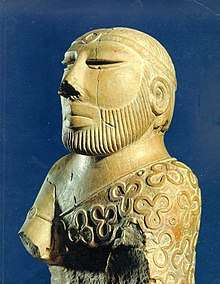
Believed to have been built in about 2,600 BCE (some 5,000 years ago) and had a population of 35,000 to 50,000 at its peak; this historical might was one of the main centres of the Indus Valley Civilisation until 1,900 BCE, the first great civilisation of the Indian Subcontinent which flourished on both banks of the mighty River Indus from the Himalayas to the Arabian Sea and spanned much of what today is Pakistan. A melting pot of traders, fishermen and farmers, Mohenjo-daro was one of the largest, most advanced and a fine thriving city of its time, with remarkably sophisticated civil engineering and urban planning. Given its impressive ruins, one can only imagines how magnificent and intelligent the Mohenjo-daro and its ancient inhabitants would have been 5,000 years ago. Located west of the mighty Indus River, the reasons for this economic hub sudden abandonment around 1,900 BCE are uncertain; one theory is that it was due to the impact of climate change which caused change in course of Indus River.
The ruins were first discovered in 1911 and excavations started in 1922, while major excavations were carried out in the 1930s. After 1965, further excavations were banned due to fears of damage to the ruins; it is estimated that only one third of the site has been revealed thus far and some believe only 10 to 20 percent has been discovered. The site has recently threatened by erosion and, despite conservation efforts funded by both the Pakistani government and UNESCO, it is considered endangered. Some archaeologists say that it will be gone by 2030 unless there is a major new conservation initiative.
Understand
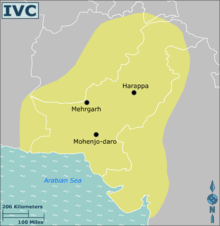
Current national borders in white
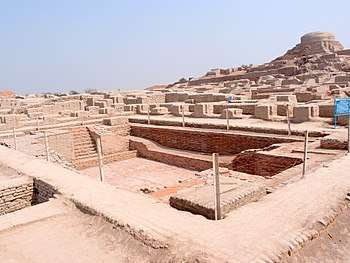
Mohenjo-daro is the modern name; it translates as Mound of the Dead. It was one of the earliest cities in the world, one of the most advanced of its time, and one of the main cities of the vast Indus Valley Civilisation (IVC) which was one of the great civilisations of the ancient world, and one of the earliest Bronze Age civilisations. It is also known as the Harappan Civilisation after another major archaeological site at Harappa, also in modern Pakistan. The terms apply to several cultures over the period 3,300-1,300 BCE, and to over a thousand sites where their artefacts have been found. The peak was the Mature Harappan period, 2,600-1,900 BCE, when Mohenjo-daro was a great thriving city.
The IVC is easily the best-known civilisation of its time in South Asia, and was almost certainly the largest and most advanced, though there are some ruins of comparable age in other parts of the subcontinent. At its height, the IVC spanned almost all of what is now modern Pakistan and parts of what are now northern India and eastern Afghanistan. It had outposts further afield, including one far to the north in Bactria. Trading links extended at least to Central Asia, Persia and the great Mesopotamian civilisations of the period in what are now Iraq and Syria. Like its contemporary civilisations, the IVC was primarily based on agriculture; irrigation and flood control were important areas of engineering. The cities handled grain storage, trade, crafts, government and education, and acted as the main religious centres.
Other civilisations were at a similar level of development in about the same time period. Cities contemporary with Mohenjo-daro included Thebes in Ancient Egypt, Nineveh and Ur in Mesopotamia and Knossos in Minoan Crete. While Ancient Egypt may have been better with building skills and constructing giant pyramids, the IVC cities were better with urban infrastructure; for example, they had the world's first municipal sewage systems as their efficient municipal government put a high priority on hygiene. They were also quite technologically advanced for the time with expertise in arts and crafts and great skills in metallurgy and hydraulic engineering. China also had well-developed cities at around that time, but the Liangzhu Culture and Longshan Culture were still Neolithic (late Stone Age).
Ancient Mohenjo-daro also seems like a socially classless society which focussed on convenience of its citizens, in contrast to the remains found in other ancient cities of that period where a vast amount of money, resources and people were allotted to building royal palaces and giant tombs, solely to serve their rulers. Evidence suggests that Mohenjo-daro was ruled by an elected body of people who may have been religious leaders and traders with healthy commercial ties with people of other civilisations at that time.
|
Epic journey through Mohenjo-daro In 2016, India's Bollywood produced an epic adventure-romance movie starring one of India's leading actors, Hrithik Roshan, in the lead role. It was a cinematic presentation referencing the ancient Indus Valley civilization with a special focus on its greatest city, Mohenjo-daro. The fictionalised story set in 2016 BC at the height of Indus Valley Civilization, and gives a interesting overview about the life of its inhabitants. The story follows a farmer who travels to the city of Mohenjo-daro for trade and falls in love with a high-status woman of Mohenjo-daro, and who must then challenge the city's rulers, and fight against overwhelming odds to save their civilization. However, the movie received some criticism both from the public as well from the Government of Pakistan for distorting historical facts but for sure, the movie does provide a fictitious version of the rise and fall of the city. |
It is believed that the period from 1900 BCE to 1300 BCE saw the decline of IVC including Mohenjo-daro. The demise of the IVC is not fully understood. Many believe that it was caused by climate change — in particular floods of the nearby Indus river and droughts due to monsoon hiatus which led to the abandonment of the city. Another theory is that it was conquered by Aryan invaders about 1,500 BCE, however no evidence of warfare, invasions or weapons have been found from the area which also gives the impression that the inhabitants of Mohenjo-daro were peaceful in nature which is remarkable if compared to its contemporary societies which were engaged in wars, destructions, bloodshed and plunders. An alternate view holds that the nomadic Aryans were assimilated by the more advanced Indus Valley culture as the Aryans spoke Sanskrit, the language of the oldest Hindu sacred texts, the Vedas, and the ancestor of all the main modern languages of Northern India and Pakistan. Sanskrit is a member of the Indo-European language family, as are almost all the languages of Europe, Persian (the modern name for Persia, "Iran", is from the same root as Aryan) and the main languages of Afghanistan, Dari (Afghan Persian) and Pushtu. It is thought that the Indus Valley people spoke a language of the non-Indo-European Dravidian group, related to the modern languages of South India and Sri Lanka. However, this is somewhat uncertain since the Indus Valley script has not been deciphered.
The extent and nature of the IVC's influence on the modern Indian subcontinent is not entirely clear. Some archaeologists see parallels between various IVC artefacts and members of the Hindu pantheon while others see more relation to religions further west, in particular the "Mother Goddess" religions of Mesopotamia and Crete. Some of the "Hindutva" nationalists talk of the "Saraswati Culture" and believe the influence was very strong.
Some links to modern culture are considered likely, though none are certain. The earliest cities along the Ganges — including Varanasi, "the spiritual capital of India" — appeared about 1,200 BCE; it is thought the founders may have been migrants from the IVC, moving east as that culture fell. The Great Bath and the many household baths at Mohenjo-daro may have been used for purification rites similar to those in modern Hinduism. Cremation of the dead became common in late Harappan culture and is now the usual custom for Hindus. A treasure of pottery, seals and other artifacts discovered from the excavated ruins points to craft technology and some items like the pottery and ox carts were well enough developed in this ancient civilisation to resemble items still made and used today.
Get in
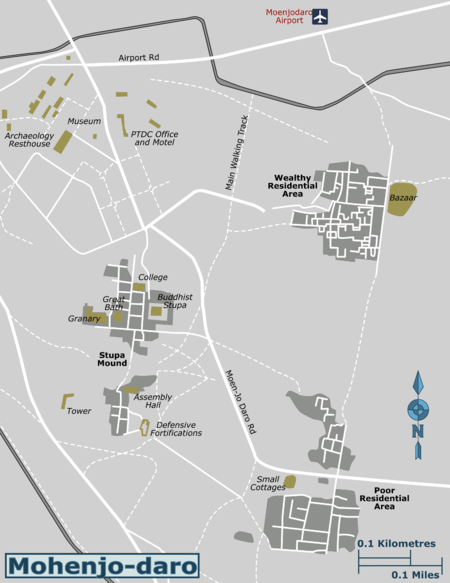
A trip to Mohenjo-daro could be tiring experience given its far flung location in middle of the rural Sindh but nonetheless it's worth a visit.
- 🌍 Mohenjo-daro Airport (MJD IATA) (adjacent to the archaeological site complex). Pakistan's flag carrier Pakistan International Airlines flies from Karachi to Mohenjo-daro. Direct flights run three times a week and take around one hour. The outdated infrastructure of the Mohenjo-daro airport prevents the use of large, advanced aircraft so smaller prop aircraft such as the ATR 42 are used. A one-way ticket costs around Rs 6,000 to/from Karachi. A shuttle bus is available on flight days to drop you at the archaeological site entrance, or the distance can be easily covered on foot.
The nearest railway station is some 11km away from the site in the outskirts of the nearby town of Dokri, but named after Mohenjo-daro. There's one train the Khushal Khan Khattak Express, each day run between Karachi and Peshawar, and makes a brief stop at Dokri early in the morning at around 6 AM. It has both air conditioned and non air conditioned coaches. The train leaves Karachi in the evening at around 9 PM, the journey takes approximately 9 hours and a non-air conditioned seat costs Rs 400 while Rs 1,000 for air-conditioned. From Mohenjo-daro railway station, a rickshaw for Mohenjo-daro archaeological site can be hired for Rs 200. Shared rickshaws are also available for Dokri for Rs 20 and from Dokri, you can hire a rickshaw for the archaeological site for Rs 150. Sometimes if train doesn't make a call at Dokri, you can always opt to to disembark at nearby town of Larkana.
Getting to Mohenjo-daro by public bus is a two-step process as there's no direct service to Mohenjo-daro. The nearest major city is Larkana, some 30km to the north, and one can easily get to Larkana by bus (either air-conditioned or not) from any major city of Sindh. From Larkana, both taxis and rickshaws can be hired for Mohenjo-daro. Moreover, vans run from Larkana up-to a bypass near the archaeological complex as well as shared motorcycle rickshaws. Hiring a taxi or a rickshaw is definitely the preferred option as both are comfortable as well as quicker than the cramped vans or shared rickshaws; they take less than an hour. Hiring a taxi for the archaeological site should cost less than Rs 1,000 if you manage to haggle well with the taxi driver whereas a rickshaw can be hired for Rs 500. Journeys on shared rickshaws may cost around Rs 100 and vans even less.
If you are driving or being driven, Mohenjo-daro can be accessed most easily by some arterial roads branching off (at Mehar, Nasirabad and Larkana) from the 1,264km-long National Highway # N-55 (the Indus Highway) which runs between Karachi and Peshawar.
- 🌍 Moen-Jo-Daro Car Park.
Get around
|
Protect Mohenjo-daro, it has the risk of being lost forever. Once a symbol of the wealth and grandeur of the Indus Valley Civilization, today Mohenjo-daro slowly turning to dust. Due to negligence and no concrete preservation, Structures at Mohenjo-daro has been significantly vandalised and damaged for decades and are in the state of crumbling. Experts suggested Moenjo-daro could be completely diminished within the next 20 years if strict measures are not taken quickly to save and protect it. At the very least, avoid climbing over the ancient structures while touring the site and play your part to keep the site protected and preserved. |
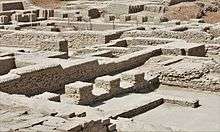
It is nothing less than absolutely thrilling and amazing to walk through the 5,000-year-old city. The archaeological ruins are widely scattered inside a vast complex, surrounded by a protection wall and only accessible through a large main entrance gate. The complex can be covered on foot easily, and it is a pedestrians-only area; no other means of transport is allowed, not even bicycles. Pathways are constructed of bricks connecting ruins scattered far and wide but note that walking can be quite exhausting and tiring, especially in the heat of summer. Make sure you wear proper and comfortable walking shoes and have a bottle of water with you when you explore the ancient city. It is also advisable to wear sunglasses and hats. Watch your step while walking through the ancient structure, as snakes have been sighted; they pose a hazard only if you disturb them.
The archaeological site is divided into two sectors: a higher settlement to the west and a larger lower settlement to the east. Facilities such as the museum, shops, park, canteen and resthouse are in a separate area a bit to the north, all near the entrance gate. Both settlement sectors are further subdivided into several areas, whose names are derived from the names of the archaeologists who excavated the ruins in the area. Everything is properly marked so it is quite easy to navigate and understand where you are and which structure is what.
The entrance fee for the whole complex is Rs 300 for foreigners, and only Rs 20 for locals. Interestingly, Mohenjo-daro is also depicted on the Rs 20 currency note. The complex is open between 08:30 and 19:00 from April to September, and between 09:00 and 17:00 in winter from October to March.
See
|
Lost artefacts of the lost city Some of Mohenjo-daro’s best-known relics are actually elsewhere, though the on-site museum has good replicas. The iconic sculpture of the priest-king is at the National Museum in Karachi, and others left what is now modern Pakistan before 1947; the bronze statuette of a naked dancing girl is in India's National Museum in Delhi, and some are in the British Museum in London. Other museums in both Pakistan and India also have relics of the Indus Valley Civilisation; in particular the Lahore Museum has a good collection. |
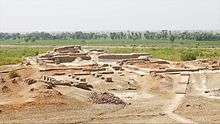
_by_Usman_Ghani.jpg)
The actual excavation has two main areas, east and west. The higher settlement to the west has the ruins of ancient administrative buildings and some that were likely residences inhabited by the rulers while lower settlement to the east was mainly a residential area for people of middle and lower class. Most of major structures including the Great Bath, Granary, College and Assembly Hall can be found on citadel mound, which is a massive unbaked mud-brick platform with many buildings constructed and believed to have been a sacred part of this city.
The lower settlement further divided into two areas: the wealthy residential area to the north had the mansions of the wealthy while the poor residential area to the south had much smaller structures, believed to be inhabited by the common people.
Very little of the acropolis has been excavated so far, but it shows advanced architecture and urban planning which is one of the most distinguishing feature of IVC and was not seen anywhere else in the ancient world. This was a grid-like pattern city similar to other urban cities of the IVC and had a precise road plan and was built on a grid system with some of the quite straight streets as wide as 10m to accommodate carts and perpendicular to each other in such a remarkable manner which divided the city in several rectangular blocks.
A rare thing to be found in even modern villages of Pakistan today, Mohenjo-daro had channeled sanitisation system. The impressive structures of the sewerage and drainage system can still be identified very easily which the city had for connecting public and private baths and wells and appears to be providing comfort and convenience to its people in hygienic environment.
Not magnificent but simple and multi-storeyed rectilinear houses were made by standard size bricks. House were varying of size but had a similar layout and proper sanitation system. Some tend to had courtyards surrounded by bedrooms, kitchen, and even servants' quarters.
Adjoining the wealthy residential area, there is also what is thought to be a large bazaar while one building that has been excavated has circular depressions into the ground, leading many to believe that it was a dyer's workshop and that the depressions were used to hold pottery vessels. In summary, the lower settlement has a variety of structures and building with amazing designs — residences, workshops, and public facilities such as stupas, baths, wells and a guardhouse.
Some of the major structures of Mohenjo-daro are described below;
- 🌍 The Buddhist Stupa. Visible from a great distance, is the highest and most prominent structure in Mohenjo-daro. The stupa, printed on Pakistani twenty rupee notes, was built atop the citadel mound long after the fall of the ancient city. This later addition to Mohenjo-daro is from the Kushan Empire, 1st to 4th centuries CE, while all of the other excavated ruins are from 2,600-1,900 BCE and is believed that the Buddhist Stupa was built over the temple, where Hindu deities were worshipped by inhabitants.
- 🌍 The Great Hall (Granary). The Great Hall is a large building and is believed to may have been a granary; it has what appear to have been a loading platform for carts transporting grain and a ventilation system to prevent spoilage. An alternate theory is that it was a public hall; the actual function of the building has not been determined.
- 🌍 The Great Bath. A 2.4m deep, 12m long, and 7m wide pool known as "The Great Bath" in the centre of higher settlement is the best-known structure of Mohenjo-daro. It is made of fine baked waterproof mud bricks and a thick layer of bitumen (natural tar – presumably to keep water from seeping through the walls), which indicates that it was used for holding water. Many scholars have suggested that this huge deep bath could have been a place for ritual bathing or religious ceremonies. It is the earliest public water tank of the ancient world. Adjacent to it is a well that was used to supply water to the bath.
- 🌍 Assembly Hall (Pillared Hall). This brick pillared structure of approximately 27.5 meter square is thought to may have been an assembly hall, a place for people to sit for meetings and social gatherings. Some believe it to be prayer hall or a palace.
- 🌍 College of Priests. A unique large open space and courtyard is refer to as a college building. Lying to the east of the Great Bath, this large building having several rooms and three verandas, with several windows, two staircases leading to roof and upper floor, is thought to have been the residence of a very high official priest or college for priests.
- 🌍 Mohenjo-daro Archaeology Museum. Open between 08:30 and 12:30 and between 14:30 and 17:30 from April to September, and between 09:00 and 16:00 from October to March. The museum was inaugurated in 1967, and contains relics found at the archaeologic site. The relics include weapons, engraved seals, kitchen utensils, sculptures and terracotta toys. Jewellery and other ornaments are showcased on the first floor and illuminated in natural light while heavy stones found during excavation are kept as well. A wall on the first floor is illustrated with an conjectural yet impressing view of the ancient city of Mohenjo-daro. Rs 300 for foreigners, Rs 20 for locals.
Buy
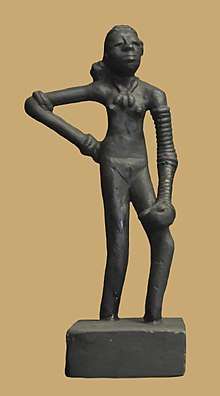
Among the most popular souvenirs are replicas of two famous pieces of sculpture found at Mohenjo-daro: the 'Dancing Girl', and the 'Priest-King' as well numerous seals and ancient jewellery. The 'Dancing Girl' is some 4,500 years old and was found in 1926; the bronze statuette is an image of a young dancer wearing nothing but bangles and a necklace. The 'Priest-King', was found in 1927 and has become symbolic of the Indus Valley Civilisation; the soapstone sculpture is of a bearded male believed by some to be a priest or monarch who had ruled Mohenjo-daro; however, there is no evidence that Mohenjo-daro was ruled by a priest or monarch.
You'll find locals selling these souvenirs inside the Mohenjo-daro complex. There's a good gift shop adjacent to the site near the entrance gate where you can buy many kinds of souvenirs as well. Various stones, post cards, photographs and books on Mohenjo-daro can be purchased both from the gift store and local sellers. The museum also sells books and photo postcards of Mohenjo-daro.
Eat and drink
Water and tea are the main choices to combat the dry climate. The cafeteria inside the archaeology rest-house admits any paying customer (no rest-house stay required), provides some food and can cater to many people at once. Alternatively, there is a cafeteria inside the complex near the museum building where one can take a rest in open-air on lush green ground after a tiring stroll and refresh yourself with drinks such as juices, tea or bottled water and have some light snacks. You'll also find many hawkers inside the complex selling light packed snacks, soft drinks and bottled water to visitors.
You may better bring your own food to double your enjoyment. Many families and tour groups head to Mohenjo-daro on weekends to enjoy picnics in the lush grass parks inside the complex.
Sleep
There is only one lodging facility in Mohenjo-daro, located inside the complex and close to the archaeological site. Alternatively, there are a few good options to stay in the nearby town of Larkana. The PTDC Motel shown on the map was shut down in 2013 and remains so as of late 2014.
- 🌍 Archaeology Rest-house, ☎ +92 343 3847735, +92 313 3063317. Recently renovated accommodation is run by Pakistan's archaeological department is overall, ideal for a stay overnight and available at affordable rates. They can also provide pick and drop to/from Larkana or Badah station via car. The rest house has nine rooms with attached baths. Three air conditioned rooms, double bed, TV, and sofas are on the first floor while six non-air conditioned rooms with two single beds in each room on ground floor. Has a cafeteria, sitting area in lounge as well a big hall to accommodate large group of people for overnight stays. Cafeteria can prepare a meal according to your taste but may charge Rs 500 per person for lunch or a dinner meal while Rs 200 for breakfast. It is advised to book in advance. Rs 1500 (basic non-A/C room) Rs 2,500 (double room with A/C).
Stay healthy
|
A weather record The highest temperature recorded at Mohenjo-daro was 53.5°C (128°F) on 26 May 2010, which is the highest reliably measured temperature in Asia and the fourth-highest temperature ever recorded anywhere in the world. |
The main risk in Mohenjo-daro and nearby areas is extreme heat. You might want to visit in the cooler winter months (October to March); otherwise you should be prepared for blisteringly hot weather. Generally, June is the hottest month of the year, with temperatures around 35°C, while December and January see an average temperature of some 15°C.
It is essential to stay hydrated; carry drinks with you or buy them along the way since tap water is unsafe in the region. Consider freezing a bottle of water overnight and drinking it as it melts; this can give cold water for much of the day.
See also Hot weather for more on coping with hot weather and Pakistan#Stay healthy for health information that applies to the entire country.
Go next
- Kirthar National Park — this large park offers great natural beauty and a good variety of wildlife
- Karachi — Pakistan's biggest, most diverse and cosmopolitan city, some distance to the south
- Lahore — the country's second largest city, historically important, further away to the north